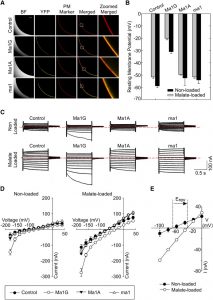Malate Transport and Apple Tartness
Acidity is a major contributor to apple (Malus domestica) fruit quality, including fruit overall taste and flavor. Organic acids collectively are  responsible for acidity, but malic acid accounts for more than 90% of the total acid and largely controls apple fruit acidity. Most of the malic acid in apple fruit resides in the vacuole of the parenchyma cells. While malate synthesis and degradation can affect fruit malate level, apple fruit acidity appears to be primarily determined by intracellular transport of malate between the cytosol and the vacuole. Malic acid accumulates in the vacuole via an acid-trap mechanism.
responsible for acidity, but malic acid accounts for more than 90% of the total acid and largely controls apple fruit acidity. Most of the malic acid in apple fruit resides in the vacuole of the parenchyma cells. While malate synthesis and degradation can affect fruit malate level, apple fruit acidity appears to be primarily determined by intracellular transport of malate between the cytosol and the vacuole. Malic acid accumulates in the vacuole via an acid-trap mechanism.
Low fruit acidity in Arabidopsis is strongly associated with truncation of Ma1, an ortholog of ALUMINUM-ACTIVATED MALATE TRANSPORTER9 (ALMT9). Li et al. (10.1104/pp.19.01300) report that both the full-length protein, Ma1, and its naturally occurring truncated protein, ma1, localize to the tonoplast in Nicotiana benthamiana. When expressed in Xenopus laevis oocytes and N. benthamiana cells, Ma1 mediates a malate-dependent inward-rectifying current, whereas the ma1-mediated transmembrane current is much weaker, indicating that ma1 has significantly lower malate transport activity than Ma1. RNA interference suppression of Ma1 expression in various apple calli results in a significant decrease in malate level. Genotyping and phenotyping of 186 apple accessions from a diverse genetic background of 17 Malus species combined with the functional analyses described above indicate that Ma1 plays a key role in determining fruit acidity and that the truncation of Ma1 to ma1 is genetically responsible for low fruit acidity in apple.



